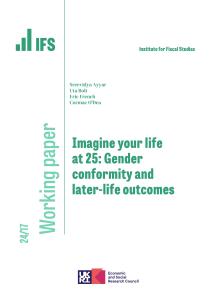The Government announced in the Spending Review 2010 that it would withdraw the Education Maintenance Allowance (EMA), a payment of up to £30 a week to children from poorer families who remain in post-16 education, from September 2011. The Government defends its intention to scrap EMA - and replace it with a smaller payment - on the grounds that the EMA is expensive and fails to deliver enough bang for its buck. But what does the evidence on the effectiveness of the EMA show?
What impact has the EMA had?
Previous work by IFS researchers found that the EMA significantly increased participation rates in post-16 education among young adults who were eligible to receive it. In particular, it increased the proportion of eligible 16-year-olds staying in education from 65% to 69%, and increased the proportion of eligible 17-year-olds in education from 54% to 61%. Based on these impacts, and on estimates of the financial benefits of additional education taken from elsewhere in the economics literature, the study concluded that the costs of providing EMA were likely to be exceeded in the long run by the higher wages that its recipients would go on to enjoy in future.
This study was not able to examine the impact of the EMA on the likelihood of getting qualifications, but a subsequent report by IFS researchers found that in areas where EMA was available, students as a whole were around 2 percentage points more likely to reach the thresholds for Levels 2 and 3 of the National Qualifications Framework; they also had A Level grades around 4 points higher (on the UCAS tariff) on average.
Is the EMA an effective use of public money?
The Government argues that the impact generated by the EMA does not justify the £560 million spent on this policy in England. Underpinning this argument is a finding from some qualitative research. One of the questions asked those who were in receipt of EMA what they would do in its absence: only 12% reported that they would not be in education. The Government infers from this that the EMA policy carries a 'deadweight' of 88%, i.e. 88 out of every 100 students receiving EMA would still have been in education if EMA did not exist and are therefore being paid to do something they would have done anyway. The estimates from the IFS research reports above imply a level of deadweight that is consistent with this: 65 out of every 69 individuals aged 16 who are eligible for the EMA would have stayed in education without the payment. But does this mean that the money spent on EMA has been wasted?
If the purpose of EMA is to increase participation in education, then the higher the deadweight, the less valuable it will be. The question is: to what extent does the "wasted" spending on those whose behaviour was unaffected offset the beneficial effect of the spending on those whose behaviour was affected? The simple cost-benefit analysis mentioned above suggests that even taking into account the level of deadweight that was found, the costs of EMA are completely offset.
Furthermore, the key assumption behind the Government's methodology for calculating the deadweight is that the impact on participation is the only outcome that matters. But the EMA may have other benefits: those who receive EMA and would have stayed in education regardless of it might still benefit educationally through other channels: for example through better attendance, or more study time as a result of not having to take on a part-time job. Moreover, even if the EMA had no impact on educational outcomes it would still represent a transfer of resources to low-income households with children, which may in its own right represent a valuable policy objective.
Many public policies involve a high amount of deadweight. For example, the coalition Government announced in its June 2010 Budget the temporary relief of Employer National Insurance Contributions (NICs) for new businesses located outside the South East and Eastern England, in order to stimulate private sector growth across the rest of the UK. The Treasury's costing of this policy implies that 96% of the foregone revenue from this tax cut will go to employers who would have set up anyway (given the natural rate of business turnover) and that 4% will go to employers who have set up in response to the incentives created by the policy. If the sole aim of the policy is stimulate new business then this would be regarded as 96% deadweight. (But if the objective of the policy were to support new businesses in these regions regardless of whether or not they had started up anyway then the assumption underpinning the deadweight calculation would not be valid.)
Another example - more similar to the EMA - is the payment of Child Benefit to households with children over 16 who are in full-time education; EMA was initially conceived as a replacement for this. If the objective of this payment is to encourage 16-year-olds to stay in full-time education then it almost certainly has greater deadweight than EMA (it is also paid to higher income households, whose children are even more likely to remain in education anyway). But in the Spending Review the Government decided to protect this benefit: one might argue that a consistent approach would mean removing this as well as EMA.









